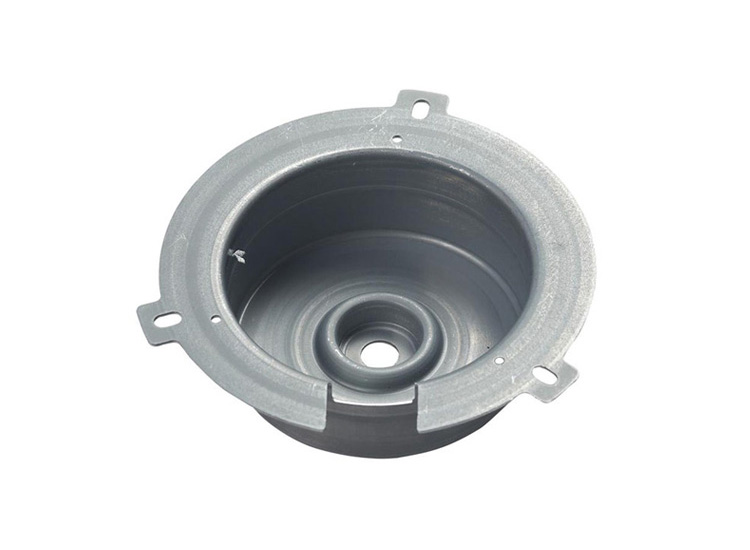The waste moving up refers to the phenomenon that after the material is cut and separated in the punching process, the material remaining in the concave die is taken out with the rise of the punch, and then falls on the surface of the concave die. In the process of stamping production, if the phenomenon of waste upward movement occurs, on the one hand, personal accidents will occur due to careless operators; On the other hand, it will also cause major quality problems such as product scrapping and mold damage. Therefore, appropriate preventive measures must be taken to prevent the waste from moving upward.
Causes of upward movement of waste materials
The root cause of the waste moving up is "adsorption force between the waste and the punch > friction force between the waste and the die + waste gravity". In particular, thin plate small blanking, the friction between the material in the die and the die is small, which can easily cause the waste to move up. In the actual production process, the specific reasons are more complex, mainly the following.
(1) When the gap between the punch and the die is too large, the waste is prone to move up.
(2) Due to the polishing or high-precision grinding of the straight wall of the concave die, the straight wall part of the concave die is too smooth, and the waste is easy to move up.
(3) The straight wall of the concave die is too high, the stored waste is too much, the downward friction increases, and the waste is easy to move up.
(4) The waste does not fall smoothly, and it meets other parts below the edge of the concave die, causing the waste to be blocked and easy to move the waste.
(5) When the sheet is blanked, the shape of the blanking waste is large and thin, and it is tightly adsorbed under the punch.
(6) Due to the use of high-viscosity lubricating oil, adhesion is caused by large adhesion.
(7) After die grinding, the cutting edge is too sharp.
(8) The position and function of the discharge plate are inappropriate, and the clearance with the punch perimeter is uneven.
(9) In the process of mold processing or stamping production, magnetic properties are generated above the punch and adsorption occurs.
(10) In the process of stamping production, the punch is inserted into the deep cutting of the concave die.
(11) There is an error in the shape of the die processing, when punching, the size of the discharged waste d is smaller than the diameter of the die hole D, and the waste is easy to move up.
Coping measures for waste moving up
In the actual production process, in order to prevent the waste from moving up, the following measures are usually taken.
2.1 Take improvement measures on the punch
(1) When the material is very thin, it is easy to adsorb at the bottom of the punch due to the adhesion of the oil, magnetism, vacuum and other reasons, and improve the punch to reduce the contact area between the punch and the waste, so as to reduce the adsorption of the punch to the waste. In actual production, several types of protruding punch, concave punch and stiffened punch as shown in Figure 1 are often used.
(2) Ejector punch, as shown in Figure 2. Step holes are machined in the punch, and the punch pin and spring are arranged. When blanking, the extrusion of the sheet material presses the pin into the punch. When unloading, the punch pin is pushed out by the spring, and the waste top on the suction punch falls inside the concave die, without causing the waste to move up.
(3) Punch with porosity, as shown in Figure 3. A hole is processed in the center of the punch, and the hole is connected with high pressure air. After blanking, the high pressure air will blow the waste and blow out the working range of the die.(4) Oblique cutting punch, as shown in Figure 4. The punch edge is processed into the material surface. When punching, the edge end first contacts the material. With the depth of the punch, the material is cut off, and the waste and the punch are not easy to form a vacuum to prevent the waste from moving up.
(5) In mass production, the punch cutting edge will produce magnetic and absorb waste due to friction, so it should be regularly degaussed.
2.2. Take improvement measures on the die
(1) As shown in Figure 5A and B. The waste is not easy to plug, easy to fall, and has the effect of preventing the waste from moving up.
(2) On the inner side wall of the concave die, the inclined groove at more than 2 places is processed in the opposite direction from the center, and its depth is about 0.005mm-0.1mm. At the beginning of blanking, the blanking waste will form a small protrusion corresponding to the inclined groove of the die. As the punch is pressed in further, the protruding part is compressed by the side of the die, increasing the friction force to prevent the waste from moving up. The shape of the die is shown in Figure 6.
(3) The inner side wall of the mold is designed to be convex at the depth direction of 2mm to 3mm, and the thickness is about 0.01mm. With the further pressure of the punch, the waste is squeezed here, and the friction increases, which can prevent the waste from moving up. The shape of the die is shown in Figure 7.
(4) For punching holes with low dimensional accuracy requirements, coarse-grained grinding wheels are used when grinding the straight wall of the die, so that the roughness of the straight wall part of the die is not too high, reducing the possibility of waste moving up;
(5) Because the collision between the waste and the lower part of the cutting edge of the concave die will cause burr blockage, and then cause the waste to move up, the lower part of the straight wall of the concave die needs to be polished.
(6) The straight wall part of the concave die is too long, and it is easy to produce waste moving up, so the depth of the concave die can be minimized under the premise of ensuring the strength.
2.3. Other improvement measures
(1) When it is easy to produce waste, the depth of the punch insert should be controlled between 3mm-5mm, and the blocked waste is limited to three pieces.
(2) Select a reasonable blanking gap value and correct it.
(3) In mass production, due to the friction between the punch and the die will produce magnetism, and the cutting edge should be degaussed regularly.
(4) The suction is generated by vacuum, the surface and roughness of the inner surface of the cutting edge of the die are increased, the cutting edge of the die is slightly chamfered, and the contour shape and blanking clearance are changed.
(5) The material leakage part of the lower part of the concave die should be kept smooth and reasonable in structure.










